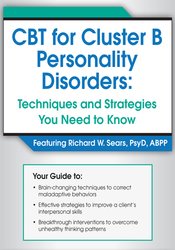

Clients with cluster B personality disorders (borderline, antisocial, histrionic, and narcissistic) can be amongst the most challenging for therapists. Clinicians who are not properly trained can inadvertently make clients worse, and can even put themselves at risk for licensure board complaints.
However, when equipped with a deeper understanding of these disorders and the most effective principles and techniques, it can be extremely rewarding to witness the positive ripple effects that occur in these clients and their families.
In this recording, join clinical psychologist and author Dr. Richard Sears for a compassionate yet direct approach for working with these individuals using cutting edge, practical interventions that are grounded in theory.
You’ll learn:
With solid principles and detailed case examples, Dr. Sears will bring these concepts and methods to life with passion and humour, giving you practical take-aways to use in your very next therapy session!
| File type | File name | Number of pages | |
|---|---|---|---|
| Manual - CBT for Cluster B Personality Disorders (2.1 MB) | 42 Pages | Available after Purchase |

Richard Sears, PsyD, PhD, MBA, ABPP, is a licensed psychologist in Cincinnati, Ohio, board certified in clinical psychology by the American Board of Professional Psychology (ABPP), runs a private psychology and consultation practice, and is the director of the Center for Clinical Mindfulness & Meditation. He has run hundreds of mindfulness groups and was lead clinician in the first brain scan study involving mindfulness with children and adolescents. He is also an adjunct professor in the University of Cincinnati psychology department, clinical research faculty at the UC Center for Integrative Health and Wellness, volunteer professor of psychiatry & behavioral neurosciences at the UC College of Medicine, and a former research/psychologist contractor with the Cincinnati VA Medical Center.
His most recent books include ACT with Anxiety (PESI); The ACT Flip Chart (PESI); Cognitive Behavioral Therapy & Mindfulness Toolbox (PESI); Mindfulness: Living Through Challenges and Enriching Your Life in the Moment (Wiley-Blackwell); Building Competence in Mindfulness-Based Cognitive Therapy (Routledge); and Mindfulness-Based Cognitive Therapy for PTSD (Wiley-Blackwell).
Dr. Sears is a sixth-degree black belt in Ninjutsu, and once served as a personal protection agent for the Dalai Lama with his teacher, Stephen K. Hayes. He has studied Eastern Wisdom for over 40 years, receiving ordination in three traditions, and transmission as a Zen master.
Speaker Disclosures:
What You Need to Know about Cluster B Diagnoses and Approaches
CBT Treatment Strategies and Techniques for Cluster B – Your Guide to Practical Application
Behavior – How to Approach Maladaptive Behavior, Self-Sabotage, Manipulation and Attention Seeking
Cognitive – How to Recognize and Interrupt Unhealthy Thinking Patterns
Mindfulness and Acceptance - Break Free of Distressing Thoughts, Feelings and Behaviors
Special Clinical Considerations for Personality Disorder Practitioners
Please wait ...